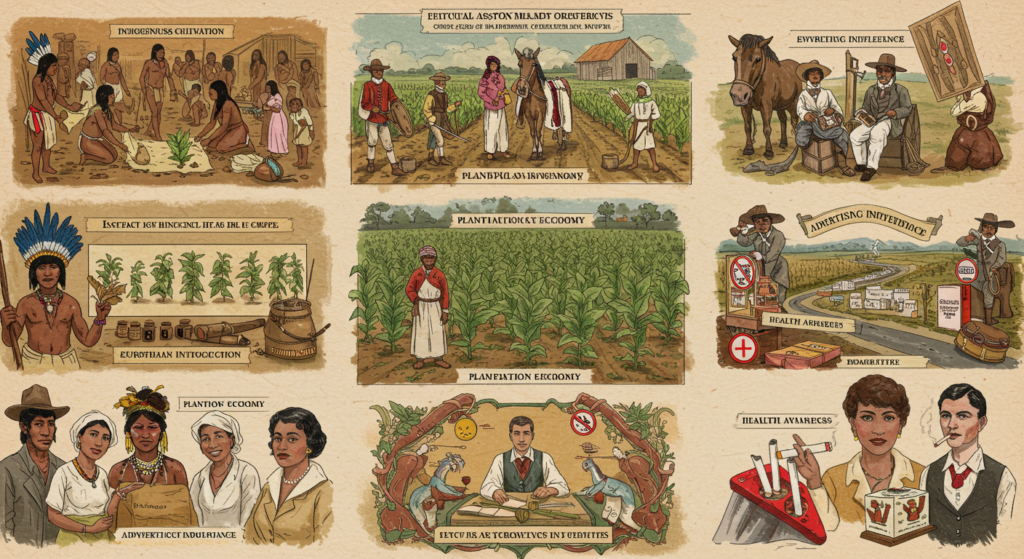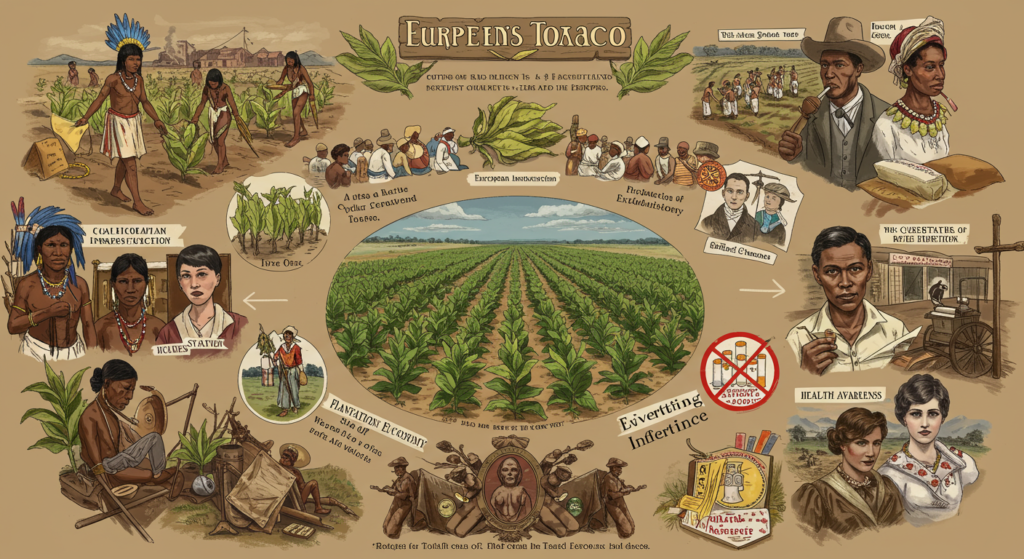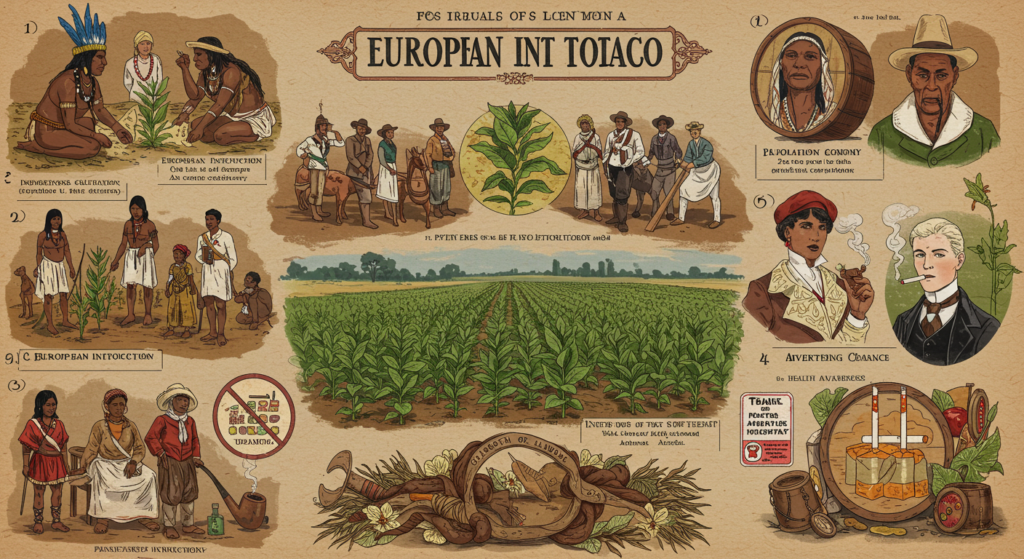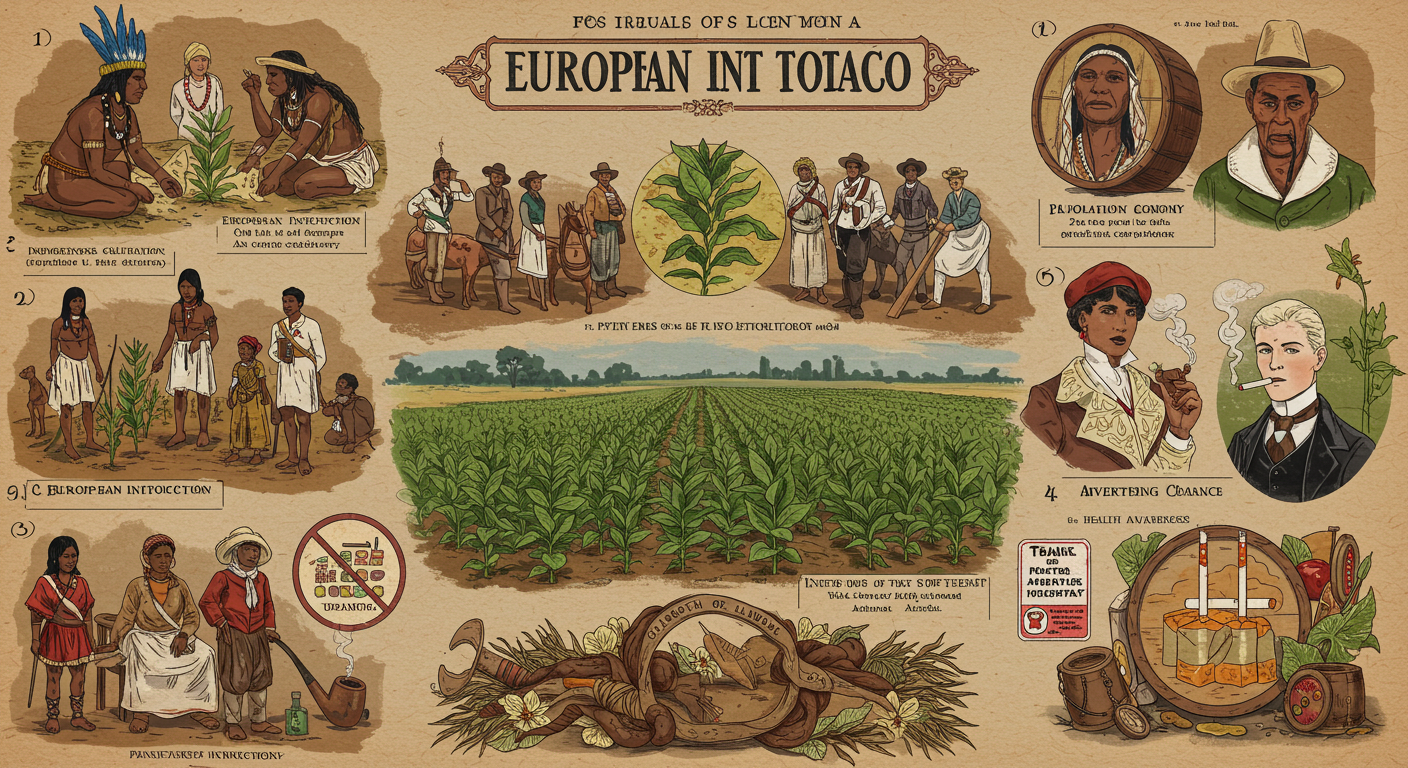The narrative of tobacco industry development showcases intricate connections between cultural practices, economic factors, and health implications. The origins of tobacco cultivation trace back to indigenous communities in the Americas, who have utilized the plant for millennia. These early cultivation methods set the stage for tobacco’s eventual worldwide prominence.
The significance of these methods cannot be overstated, as they laid the groundwork for future agricultural practices.
Tobacco’s introduction to Europe in the late 15th century marked a significant turning point. Early settlers recognized its potential as a cash crop, which greatly influenced the Southern U.S. economy. This reliance on tobacco farming also led to the exploitation of enslaved Africans, highlighting the darker aspects of its commercialization. This exploitation raises important ethical questions about the origins of wealth in the tobacco industry.
The history of tobacco farming in America is deeply intertwined with the labor of enslaved Africans, whose forced labor was crucial to the establishment and profitability of tobacco plantations.
Emphatically, the 20th century saw a shift towards widespread cigarette use, fueled by innovations like the cigarette-making machine and aggressive advertising campaigns that glamorized smoking.
In the final analysis, the history of tobacco control reflects a growing awareness of health risks associated with tobacco use. Early advertising often promoted tobacco as beneficial, but this narrative changed over time. Today, stringent regulations aim to reduce tobacco consumption, showcasing the ongoing conflict between public health advocates and tobacco companies.
Discover the Untold Stories of the History of Tobacco Industry and Its Cultural Significance
Tobacco has a rich history, originating with indigenous peoples in the Americas and later becoming a significant cash crop for European settlers. Evidence shows that indigenous cultures cultivated tobacco for thousands of years, using it in various rituals and as a trade item. This early use laid the groundwork for tobacco’s eventual global spread.
Such practices were not merely economic; they were deeply embedded in the cultural identities of these communities.
In truth, early settlers in America adopted tobacco farming, establishing large plantations that became central to the economy. As tobacco became a significant part of the economy in the Southern United States, it not only shaped agricultural practices but also influenced the region’s social and political structures. This influence extended beyond economics, affecting the very fabric of Southern society.
The history of tobacco farming in America reveals a complex relationship with labor and exploitation. Enslaved Africans were brought to work on these plantations, highlighting the dark side of tobacco’s profitability. This exploitation fueled the growth of the tobacco industry, which became a cornerstone of the Southern economy.
Additionally, the 20th century marked a shift towards mass consumption, driven by innovations in production and marketing strategies.
Aggressive advertising campaigns transformed the public perception of smoking. Tobacco companies promoted cigarettes as glamorous and sophisticated, leading to widespread acceptance. On the whole, the cost of cigarettes decreased, making them accessible to a wider audience and contributing to their rapid rise in popularity.
This accessibility played a crucial role in shaping smoking habits across various demographics.
As awareness of health risks grew, the history of tobacco control began to take shape. Public health advocates fought against the tobacco industry’s influence, pushing for regulations to protect consumers. Today, stringent laws aim to reduce tobacco use, reflecting a significant shift in societal attitudes towards smoking.
In the final analysis, the history of the tobacco industry illustrates a complex interplay of culture, economy, and health. The journey from indigenous cultivation to global commercialization reveals both the benefits and harms associated with tobacco. Understanding this history is essential for addressing the ongoing challenges posed by tobacco use.
The History Of Tobacco Farming Exposes the Painful Legacy of Slavery
A surprising fact is that the history of tobacco farming in America highlights the exploitation of enslaved Africans whose labor was crucial to the economic and social development of the Southern United States. This dark chapter in history reveals how tobacco became a driving force behind the region’s growth. The labor of enslaved individuals not only fueled the tobacco industry but also shaped the social fabric of the South.
The implications of this growth were felt across generations, shaping societal norms and values.
In the history of tobacco farming, enslaved Africans played a pivotal role. They toiled under harsh conditions on vast plantations, cultivating tobacco that became a lucrative cash crop. This exploitation significantly impacted the economy of the Southern United States, intertwining the fates of agriculture and slavery. As tobacco production expanded, it influenced social hierarchies and political structures, creating a complex relationship between wealth and oppression. This relationship underscores the intertwined nature of economic prosperity and human suffering.
To put it another way, the history of smoking evolved alongside tobacco farming. Tobacco companies capitalized on this trend, promoting cigarettes as symbols of sophistication and freedom. This marketing strategy not only increased sales but also entrenched smoking in American culture, despite the health risks associated with tobacco use.
As awareness of these health risks grew, the history of tobacco control emerged. Public health advocates began to challenge the tobacco industry’s influence, pushing for regulations to protect consumers. Today, the legacy of tobacco farming and its impact on society continues to shape discussions around public health and regulation, highlighting the ongoing struggle between economic interests and health advocacy.

History of Tobacco Industry Reveals Shocking Truths About Our Smoking Habits
A surprising fact is that the evolution of smoking practices reflects a complex interplay of cultural significance, social status, and technological advancements throughout history. Various cultures viewed smoking as a sacred act, often using it in ceremonies to connect with the spiritual world. These practices highlight the diverse meanings attributed to tobacco across different societies.
The late 1800s marked a pivotal moment in the history of tobacco industry with the invention of the cigarette-making machine. This innovation revolutionized tobacco production, allowing for mass manufacturing of cigarettes. Consequently, the cost of cigarettes decreased, making them accessible to a wider audience and contributing to their rapid rise in popularity.
This accessibility played a crucial role in shaping smoking habits across various demographics.
Furthermore, the history of smoking can be traced back to ancient rituals and medicinal practices among various cultures. Smoking served as a means of connecting with the spiritual realm, often seen as a sacred act. Different cultures developed unique smoking methods, reflecting their distinct traditions and beliefs.
To sum up, the history of tobacco use illustrates a complex relationship between culture, economy, and health. Understanding this evolution is crucial for addressing the ongoing challenges posed by tobacco consumption.
The History Of Cigarettes Unveils the Glamorous Lies of Smoking
Imagine a time when a simple cigarette became a symbol of rebellion and sophistication. This transformation occurred through powerful advertising campaigns that reshaped public perception. As a result, smoking became an integral part of 20th-century culture.
This cultural integration was not without consequences, as it often overshadowed the health risks involved.
The rise of cigarette advertising significantly influenced societal views on smoking. For one thing, campaigns often featured celebrities and stylish individuals, creating an allure around cigarette use. This marketing strategy effectively normalized smoking, associating it with a desirable lifestyle.
In the 20th century, smoking gained immense popularity, becoming a cultural phenomenon. It permeated various aspects of society, including films, literature, and art. The image of the smoker evolved into an iconic representation of allure and mystique, captivating the public’s imagination. Moreover, smoking became intertwined with notions of freedom and sophistication, further embedding it into the social fabric. This association created a powerful narrative that appealed to many, despite the emerging evidence of harm.
To demonstrate, the history of tobacco advertising reveals how companies strategically targeted consumers. They crafted messages that resonated with aspirations for independence and social status. This approach not only increased cigarette sales but also solidified smoking’s place in popular culture. In contrast, public health advocates began to challenge these narratives as awareness of health risks grew.
As the history of tobacco control developed, regulations emerged to combat the influence of tobacco companies. Public health campaigns aimed to educate consumers about the dangers of smoking. Nonetheless, the legacy of cigarette advertising continues to impact perceptions of smoking today, highlighting the ongoing struggle between health advocacy and commercial interests.
Discover How the History of Tobacco Industry Shaped Our Perception of Smoking Risks

The evolution of tobacco advertising paints a vivid picture of shifting societal attitudes towards smoking and health awareness. Initially, advertisements portrayed tobacco as a symbol of sophistication, appealing to consumers’ desires for social status. Over time, however, the narrative changed dramatically as health risks became more evident. This shift in narrative reflects broader societal changes regarding health and wellness.
As tobacco advertising evolved, early campaigns often highlighted health benefits and social prestige associated with smoking. This approach reflected the prevailing attitudes of the time, where smoking was seen as a glamorous activity. For example, tobacco companies frequently featured celebrities in their ads, creating an allure around cigarette use. Nonetheless, in reality, as research began to reveal the severe health risks linked to tobacco, public perception shifted significantly.
Growing awareness of the dangers of smoking led to the introduction of tobacco control measures in the mid-20th century. Public health campaigns emerged, aiming to educate the population about the harmful effects of tobacco use. This period marked a turning point in the history of tobacco industry, as governments recognized the urgent need to protect public health. Such recognition was pivotal in shaping future public health policies and regulations.
In like manner, the history of tobacco advertising reflects these changing societal attitudes. As health implications became clearer, tobacco companies faced increasing scrutiny. They had to adapt their marketing strategies to align with the new public health narrative. This shift illustrates the ongoing conflict between commercial interests and health advocacy, a theme that continues to resonate today.
In conclusion, the evolution of tobacco advertising serves as a lens through which we can understand the broader history of tobacco use. The interplay between marketing, societal attitudes, and health awareness highlights the complexities of the tobacco industry. Understanding this history is crucial for addressing the ongoing challenges posed by tobacco consumption.
Uncovering the History Of Tobacco Companies and Their Dark Tactics
In 2020, over 1.3 billion people worldwide used tobacco products, highlighting the ongoing challenges in tobacco regulation and public health efforts.
The history of tobacco companies reveals a tumultuous journey marked by legal challenges and public scrutiny. As evidence regarding smoking’s dangers accumulated, these companies faced mounting pressure from consumers and regulatory bodies. Lawsuits emerged, targeting deceptive marketing practices, leading many companies to pay significant settlements. This legal scrutiny has prompted a shift towards greater transparency within the industry, although controversies surrounding marketing tactics persist. These controversies highlight the ongoing tension between profit motives and ethical responsibilities. The evolution of tobacco regulation reflects a complex interplay between public health advocacy and the tobacco industry’s response to legal and societal pressures.
Legislation aimed at reducing tobacco use has introduced various measures, including advertising restrictions and public smoking bans. To illustrate, graphic warning labels on cigarette packages and the prohibition of tobacco advertising in multiple media channels represent significant strides in tobacco control efforts. Such regulations aim to inform consumers about the risks associated with tobacco use, thereby fostering a healthier society. In this context, the history of tobacco control illustrates the ongoing battle between public health advocates and the tobacco industry.
The ongoing conflict between public health advocates and tobacco companies continues to shape the landscape of tobacco regulation. As new products like e-cigarettes and vaping devices emerge, the debate over tobacco regulation evolves. Public health advocates consistently push for stricter regulations to safeguard consumers, while tobacco companies strive to maintain their market presence and profitability. This dynamic interaction between advocacy and industry interests underscores the complexities of the history of tobacco industry and its regulation. Understanding these developments is crucial for addressing the challenges posed by tobacco consumption today.

As We Reflect on the History of Tobacco Industry Its Impact on Society is Unmistakable
The narrative of tobacco industry development showcases intricate connections between cultural practices, economic factors, and health implications. This journey from indigenous practices to global commercialization illustrates profound societal changes. Understanding this evolution is crucial for grasping the ongoing challenges in tobacco regulation and public health. These challenges are not merely historical; they continue to affect contemporary society.
Tobacco’s roots in the Americas are deeply tied to indigenous practices that encompassed both cultural rituals and medicinal uses. Later, European settlers recognized its economic potential, transforming it into a significant cash crop. This transformation initiated a multifaceted relationship between tobacco and societal structures, especially in the Southern United States, where the labor of enslaved Africans was integral to the expansion of tobacco agriculture. This relationship serves as a reminder of the historical injustices that shaped the industry.
As smoking practices evolved, they reflected cultural significance and social status. The rise of cigarette advertising in the 20th century transformed smoking into a symbol of freedom and sophistication. This advertising not only popularized smoking but also embedded it deeply into the fabric of modern culture, despite the growing awareness of its health risks.
The evolution of tobacco advertising mirrored changing societal attitudes towards smoking. As public health advocacy gained momentum, the tobacco industry faced increasing scrutiny and regulatory challenges. Overall, the history of the tobacco industry illustrates a complex interplay of culture, economy, and health. The journey from indigenous cultivation to global commercialization reveals both the benefits and harms associated with tobacco. Understanding this history is essential for addressing the ongoing challenges posed by tobacco use.
Listen to an AI-Generated Podcast of this Blog
Unveiling the Hidden Truths of Tobacco’s Past
Here’s a surprising fact about tobacco history. Tobacco has roots in indigenous cultures, who cultivated it for rituals and trade. Emphatically, European settlers recognized its economic potential, transforming it into a cash crop. This shift significantly impacted the Southern U.S. economy. To put it another way, the history of tobacco farming reveals a complex relationship with slavery. Enslaved Africans provided the labor necessary for tobacco cultivation. Additionally, the 20th century saw the rise of cigarette advertising. This marketing glamorized smoking, embedding it into American culture. Despite growing health concerns, tobacco companies continued to promote their products. Overall, the history of tobacco use illustrates a struggle between economic interests and public health advocacy. Understanding this history is crucial for addressing current tobacco challenges.
FAQs
What can you tell me about the history of tobacco industry development?
The history of tobacco industry development showcases connections between cultural practices, economic factors, and health implications.
How did indigenous communities influence the history of tobacco use?
Indigenous communities in the Americas cultivated tobacco for millennia, laying the groundwork for its global prominence.
What role did tobacco play in the Southern U.S. economy?
Tobacco became a significant cash crop, influencing the economy and leading to the exploitation of enslaved Africans.
Can you explain the shift towards cigarette use in the 20th century?
The 20th century saw innovations like the cigarette-making machine and aggressive advertising that glamorized smoking.
How did advertising change perceptions of smoking over time?
Initially, advertising promoted tobacco as beneficial, but awareness of health risks shifted public perception significantly.
What does the history of tobacco farming reveal about slavery?
The history of tobacco farming highlights the exploitation of enslaved Africans, crucial to the industry’s profitability in America.
How did smoking practices evolve across different cultures?
Different cultures viewed smoking as a sacred act, using it in ceremonies and developing unique smoking methods.
What impact did cigarette advertising have on society?
Cigarette advertising created an allure around smoking, associating it with sophistication and normalizing its use in culture.
How did public health advocacy influence tobacco control?
Public health advocates fought against the tobacco industry’s influence, leading to regulations aimed at reducing tobacco consumption.
What ongoing challenges does the tobacco industry face today?
The tobacco industry faces scrutiny from public health advocates and regulatory bodies, especially with new products like e-cigarettes.
Come Visit Us
We have three fantastic locations we’d love to invite you to! If you’re in the Chicagoland area, you can come chill with us at either our Grayslake or Schaumburg locations. Alternatively, if you’re in Wisconsin, stop by and visit us at our Kenosha lounge. Please note that you must be 21+ to enter with a valid ID. We hope to see you soon!


